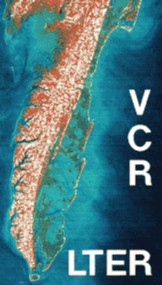 The role of tidal creeks in the development of a barrier island Spartina alterniflora marsh |

A. Christy Tyler & Jay C. Zieman
Department of Environmental Sciences
|
 The role of tidal creeks in the development of a barrier island Spartina alterniflora marsh |

A. Christy Tyler & Jay C. Zieman
Department of Environmental Sciences
|
Past studies of marsh development have been primarily associated with restored and created marshes (e.g. Broome et al. 1986, Sinicrope et al. 1990, Craft et al. 1988a, Craft et al. 1988b). These studies have examined changes in primary production (Broome et al. 1986) species composition (Sinicrope et al. 1990), nutrient and organic carbon reservoirs (Craft et al. 1988a), and the sources of organic matter in these marshes (Craft et al. 1988b). Few studies have focused on naturally developing marshes (Redfield 1965, 1972, Osgood & Zieman 1993a, Osgood & Zieman 1993b, Osgood et al. 1995). The present study examines the changes that take place over time at the creekbank of a developing marsh, and the role of the tidal creek in the successional process through the use of a chronosequence. Four creeks along the Hog Island chronosequence were chosen: two young creeks ( Y1 and Y2 ), an intermediate age creek (I) and a mature creek ( O ), which are approximately 4, 5, 13 and 150+ years old, respectively. See Table 1 for specific characteristics of each creek. The porewater chemistry, organic content, and Spartina alterniflora biomass along transects perpendicular to each creek were compared. Porewater ammonium , phosphate, and sulfide concentration and sediment organic content increased with age, while redox potential and the sand content of the sediment decreased. Mean Spartina biomass for each site increased with age, and in the younger marshes, higher biomass was significantly correlated with increased proximity to the creek. The creek water nutrients , salinity and , ( particulate matter ) concentrations were measured over the course of the tidal cycle. The smaller creeks become discontinuous with the lagoon at low tide, such that any additional drainage or run-off is entrained within the creek. At low tide, these creeks have higher nutrient and particulate concentrations than older creeks. It is suggested that the creeks act to trap nutrients and particulates on the in ebbing tide , and return them to the marsh surface on the See flooding tide . A principal components analysis was run on the sediment data, and a single vector was able to explain 49.6% of the variability in the data. This vector is strongly correlated with the age of the marsh, as well as with the distance from the creekbank in the younger marshes. The factor scores for sites closest to the creek bank in younger marshes are significantly different from those farther away, and appear to represent an ecologically "older" system. Owing to this relationship, it is concluded that the creeks act to accelerate the development of the marsh in their vicinity.
Broome, S.W., E.D. Seneca & W.W. Woodhouse, Jr.. 1986. Long-term growth and development of transplants of the salt-marsh grass Spartina alterniflora.
Craft, C.B., S.W. Broome, E.D. Seneca & W.J. Showers. 1988. Estimating sources of soil organic matter in natural and transplanted estuarine marshes using stable isotopes of carbon and nitrogen. Estuarine, Coastal and Shelf Science. 26: 633-641.
Craft, C.B., S.W. Broome & E.D. Seneca. 1988. Nitrogen, phosphorus and organic carbon pools in natural and transplanted marsh soils. Estuaries. 11: 272-280.
Osgood, D.T. & J.C. Zieman. 1993a. Factors controlling aboveground Spartina alterniflora (smooth cordgrass) tissue element composition and production in different-age barrier island marshes. Estuaries. 16: 815-826.
Osgood, D.T. & J.C. Zieman. 1993b. Spatial and temporal patterns of substrate physicochemical parameters in different-aged barrier island marshes. Estuarine, Coastal and Shelf Science. 37: 421-436.
Osgood, D.T., M.C.F.V. Santos & J.C. Zieman. 1995. Sediment physico-chemistry associated with natural marsh development on a storm-deposited sand flat. Marine Ecology Progress Series. 120: 271- 283.
Redfield, A.C. 1965. Ontogeny of a salt marsh estuary. Science. 147: 50-55.
Redfield, A.C. 1972. Development of a New England Salt Marsh. Ecological Monographs. 42: 201-237.
Sinicrope, T.L., P.G. Hine, R.S. Warren & W.A. Niering. 1990. Restoration of an impounded salt marsh in New England. Estuaries. 13: 25-30.